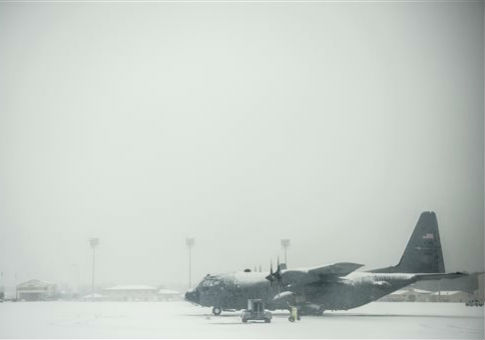The Air Force confirmed this week that it is shuttering a vital airlift wing at Fort Bragg, N.C., that trains the Army’s airborne and special operations forces, prompting outrage from the state’s lawmakers.
The Air Force finally submitted on Tuesday its "Report on C-130 Force Structure" to Congress after its release had been delayed since January. Units such as the 440th Airlift Wing at Fort Bragg’s Pope Army Airfield fly the C-130s to prepare airborne forces for emergency operations overseas.
The report affirmed that the Air Force would close the 440th, which it said would save $116 million during a time of severe budget constraints for the military. Lawmakers raised concerns last year when the Air Force began transferring airmen from the reserve unit before providing the report to Congress.
"The Air Force will retain the ability to support the Army's training and contingency response requirements at Pope AAF" despite the closing of the 440th, the report said.
Sen. Thom Tillis (R., N.C.), one of the sharpest critics of the Air Force’s plan to deactivate the 440th, said he would ratchet up the pressure on service leaders to change course. He has placed a hold on all civilian Department of Defense and Air Force appointments and pushed for language in next year’s defense appropriations bill that would prevent the transfer of personnel or aircraft from Pope.
"The report that was finally released to Congress after months of delay confirms that it has always been the Air Force’s intention to shutter the 440th Airlift Wing at Fort Bragg, a short-sighted decision that would negatively impact America’s rapid reaction and Special Forces during national emergencies," he said in a statement.
"I will pursue all options available to help stop this strategically flawed plan from being fully implemented."
Sen. Richard Burr (R., N.C.) also called the report "a complete disappointment" and said eliminating the 440th is a "terrible strategic decision." Congress has 60 days to review the report and propose alterations.
The Air Force claimed in its report that "there will be no adverse impact" on the capabilities of the 18th Airborne Corps by removing the 440th. It noted that the service’s joint training system currently fulfills 66 percent of Fort Bragg’s training missions and 100 percent of other missions at bases such as Fort Benning, Ga., and Fort Campbell, Ky.
However, those bases do not serve large airborne units such as Fort Bragg, which hosts the 82nd Airborne Division. The 440th Airlift Wing was the only reserve unit co-located with the 82nd Airborne and special operations forces.
The 440th was originally slated to receive 10 new C-130J aircraft from Keesler Air Force Base, Miss., which would have replaced the unit’s older C-130H aircraft. The Air Force has now decided to keep those planes at Keesler.
Lt. Gen. Joseph Anderson, commander of Fort Bragg and the 18th Airborne Corps, publicly expressed his opposition in February to closing the 440th. "Of all places in the world, why would we take that capability away from Fort Bragg?" he said at the time.
Tillis wrote a letter last month to Sens. Thad Cochran (R., Miss.) and Dick Durbin (D., Ill.), the leaders of the defense appropriations subcommittee, requesting a provision in next year’s defense bill that would halt the deactivation of the 440th. He noted that, "Pope AAF is the busiest airfield in the world for the performance of training requiring tactical airlift" and that the Air Force will incur additional costs by flying in planes from distant bases to train airborne units. The retiring of the 440th also comes during a period of global instability that could require the rapid deployment of airborne forces.
"This is not a parochial issue, deactivating the 440th is a tactical and strategic mistake that will impact the readiness of America’s rapid reaction and Special Forces," Tillis said. "It essentially takes the ‘air’ out of ‘airborne.’"
